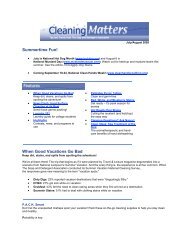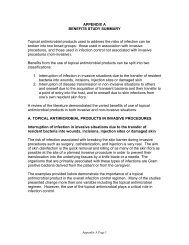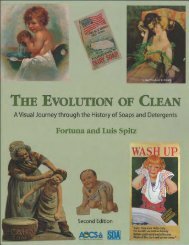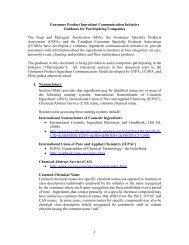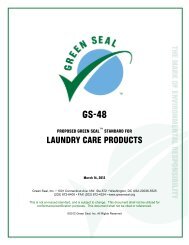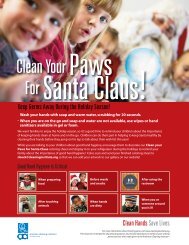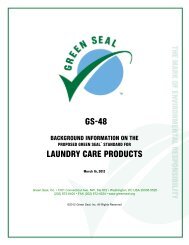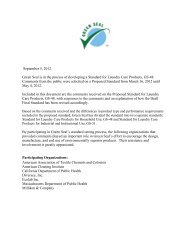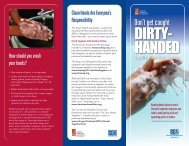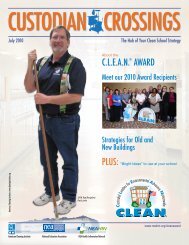subchapter c -- federal hazardous substances act regulations
subchapter c -- federal hazardous substances act regulations
subchapter c -- federal hazardous substances act regulations
You also want an ePaper? Increase the reach of your titles
YUMPU automatically turns print PDFs into web optimized ePapers that Google loves.
16 CFR Ch. II (1–1–05 Edition)—proposed modificication – 6/25/06<br />
products <strong>act</strong>ed with prudence and foresight<br />
before introducing the products into<br />
commerce, they would not have used lead at<br />
all. This in turn would have eliminated both<br />
the risk to young children and the costs and<br />
other consequences associated with the<br />
corrective <strong>act</strong>ions.<br />
(4) The Commission urges manuf<strong>act</strong>urers<br />
to eliminate lead in consumer products to<br />
avoid similar occurrences in the future.<br />
However, to avoid the possibility of a<br />
Commission enforcement <strong>act</strong>ion, a<br />
manuf<strong>act</strong>urer who believes it necessary to use<br />
lead in a consumer product should perform the<br />
requisite analysis before distribution to<br />
determine whether the exposure to lead causes<br />
the product to be a “<strong>hazardous</strong> substance.” If<br />
the product is a <strong>hazardous</strong> substance and is<br />
also a children’s product, it is banned. If it is a<br />
<strong>hazardous</strong> household substance but is not<br />
intended for use by children, it requires<br />
precautionary labeling. This same type of<br />
analysis also should be performed on materials<br />
substituted for lead.<br />
(5) The Commission also notes that, under<br />
the FHSA, any firm that purchases a product<br />
for resale is responsible for determining<br />
whether that product contains lead and, if so,<br />
whether it is a “<strong>hazardous</strong> substance.” The<br />
Commission, therefore, recommends that,<br />
prior to the acquisition or distribution of such<br />
products, importers, distributors, and retailers<br />
obtain information and data, such as analyses<br />
of chemical composition or accessibility,<br />
relevant to this determination from<br />
manuf<strong>act</strong>urers, or have such evaluations<br />
conducted themselves.<br />
§ 1500.231 Guidance for <strong>hazardous</strong> liquid<br />
chemicals in children’s products.<br />
(a) Summary. The U.S. Consumer Product<br />
Safety Commission issues this guidance to<br />
manuf<strong>act</strong>urers, importers, distributors, and<br />
retailers to protect children from exposure to<br />
<strong>hazardous</strong> chemicals found in liquid-filled<br />
children’s products, such as rolling balls,<br />
bubble watches, necklaces, pens,<br />
paperweights, keychains, liquid timers, and<br />
mazes. 1 The Commission identifies the major<br />
f<strong>act</strong>ors that it considers when evaluating<br />
liquid-filled children’s products that contain<br />
<strong>hazardous</strong> chemicals, and informs the public of<br />
its experience with exposure to these<br />
<strong>hazardous</strong> chemicals to children. To reduce the<br />
risk of exposure to <strong>hazardous</strong> chemicals, such<br />
as mercury, ethylene glycol, diethylene glycol,<br />
methanol, methylene chloride, petroleum<br />
distillates, toluene, xylene, and related<br />
chemicals, the Commission requests<br />
manuf<strong>act</strong>urers to eliminate the use of such<br />
chemicals in children’s products. The<br />
Commission also recommends that, before<br />
purchasing products for resale, importers,<br />
distributors, and retailers obtain assurances<br />
from manuf<strong>act</strong>urers that liquid-filled<br />
children’s products do not contain <strong>hazardous</strong><br />
liquid chemicals.<br />
(b) Hazard. During reasonably foreseeable<br />
handling or use of liquid-filled children’s<br />
products, <strong>hazardous</strong> chemicals may become<br />
accessible to young children in a manner that<br />
places children at risk. Young children are<br />
exposed to the chemicals from directly<br />
mouthing them or from handling such objects<br />
and subsequent hand-to-mouth or hand-to-eye<br />
<strong>act</strong>ivity. The specific type and frequency of<br />
behavior that a child exposed to a product will<br />
exhibit depends on the age of the child and the<br />
char<strong>act</strong>eristics and pattern of use of the<br />
product. The adverse health effects of these<br />
chemicals to children include chemical<br />
poisoning from ingestion of the chemicals,<br />
pneumonia from aspiration of the chemicals<br />
into the lungs, and skin and eye irritation from<br />
exposure to the chemicals. The chemicals may<br />
also be combustible.<br />
(c) Guidance. (1) Under the Federal<br />
Hazardous Substances Act (FHSA), products<br />
that are toxic or irritants and that may cause<br />
substantial injury or illness under reasonably<br />
foreseeable conditions of handling or use,<br />
including reasonably foreseeable ingestion by<br />
children, are “<strong>hazardous</strong> <strong>substances</strong>.” 15<br />
U.S.C. 1261(f)(1). A product that is not<br />
intended for children, but that creates a risk of<br />
substantial injury or illness because it contains<br />
<strong>hazardous</strong> chemicals, requires precautionary<br />
labeling under the Act. 15 U.S.C. 1261(p). A<br />
toy or other article intended for use by<br />
1 This guidance is not a rule. It is intended to<br />
highlight certain obligations under the Federal<br />
Hazardous Substances Act. Companies should read<br />
-- 97 --<br />
that Act and the accompanying <strong>regulations</strong> in this<br />
part for more detailed information.



